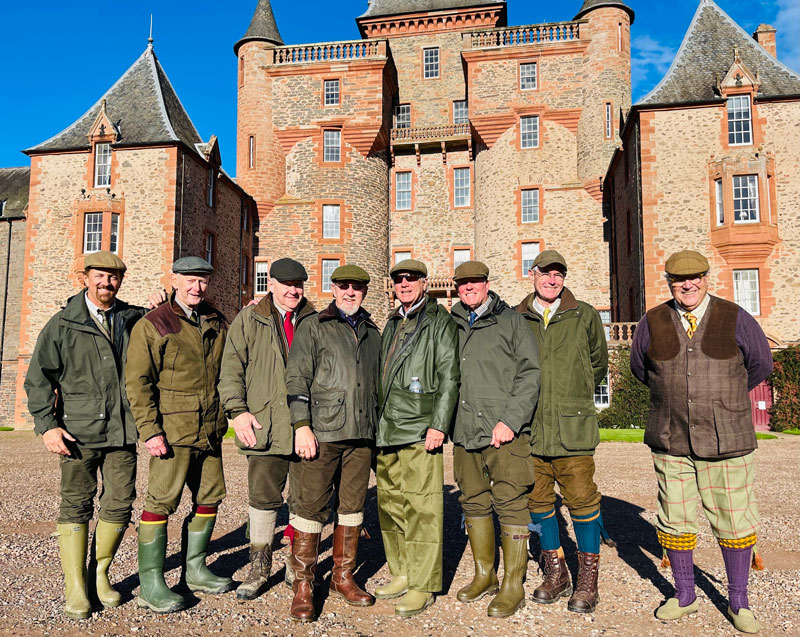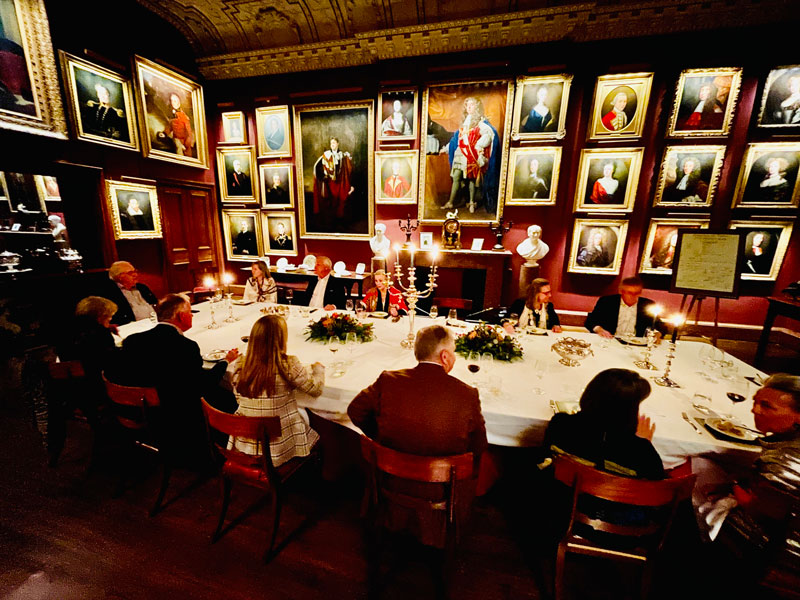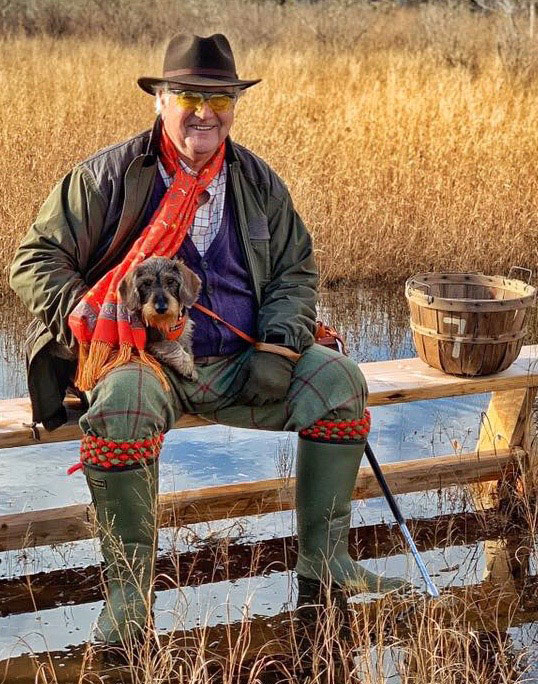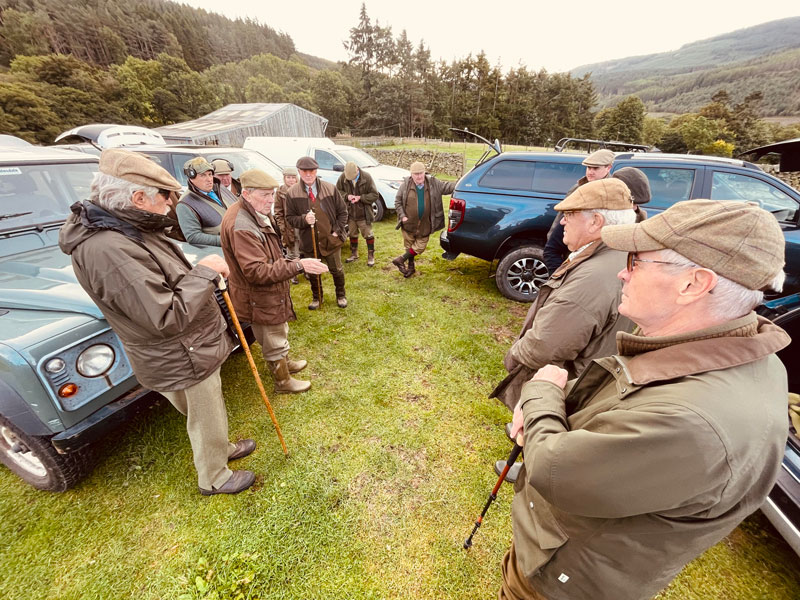Of all the uses of a shotgun, none ranks higher than to be employed for a driven-bird shoot. This is the Sport of Kings made possible by the advent of the breechloading shotgun in the late 19th Century, allowing a gunner to shoot thousands of rounds in a single day. Driven shooting was viewed as an especially nice way to spend an autumn day in the countryside when things got a bit stuffy in London.
Lords and Ladies would hop trains bound for castles with accoutrement to last for a few days of pheasant and grouse shooting by day followed by formal dinners by night where there was plenty of wine. Always plenty of wine. In fact, other than birds, wine and port might have been the most important ingredients to the shoot and a key measure of the quality of the experience.

DORSEY PICTURES
The concept was straightforward: A line of royalty armed with a matched pair of side-by-side shotguns from one of London’s bespoke makers—Holland & Holland, Purdey, Boss, Churchill, etc.—stretched along the bottom of a slope. Meanwhile, a row of beaters marched down the hill toward the Guns to flush waves of birds over them. Think of it as the Call of Duty: Bird Shooting edition, with sometimes staggering numbers of cartridges fired.
Such scenes were memorialized in the Academy Award-winning film Gosford Park as well as in episodes of the hit series Downton Abbey. In the Edwardian period there was no activity that more surely signaled your position atop the societal food chain than invites to the best shoots on the British Isles. It was proof that it was, in fact, good to be King . . . or Prince, Duke, Duchess, Earl, [insert other aristocracy].
To be clear, driven shooting is not to be confused with hunting, for these birds are raised for the sole purpose of the activity and then are sold to market, eventually becoming pies served with rice and cranberries. Shooters pay handsomely to participate, and the combination of sport and poultry sales provides employment in areas where jobs are scarce and wool prices are currently waning. Thus, driven shooting remains an important economic activity in rural parts of Scotland and elsewhere across the whole of Europe.

DORSEY PICTURES
While the glorious shoots of the Edwardian Age have given way to decidedly more modest affairs, driven shooting remains an indelible part of the countryside culture. The people who consistently organize the best shoots have become niche celebrities, developing a following among today’s royalty—titans of tech, pharmaceuticals, media, energy and the like.
No one fits that description better than Wilson Young, who has been the kingpin of many of the best British shoots for more than 40 years. I first met him 20 years ago when I joined a line of shooters on the moors of Northumberland for a mix of pheasant and partridge gunning, one of the many events offered as part of his Eskdale Shooting Services.
Given that history, I was eager to return to see how Young had faired and whether his shoots had withstood the test of time. Making that possible was Jan Roosenburg, best known in wingshooting circles for his tenure at the helm of Holland & Holland from 1991 to 2001 and a man I met 30 years ago while working in the publishing business in Los Angeles. He has been traveling annually to Scotland to shoot with Wilson for the last 15 years, testament to the sustained quality of Young’s shoots.

JAN ROOSENBURG
Our group consisted of nine couples from Brays Island, a community in the Lowcountry of South Carolina where the only debate about gun control is whether one can hit a fast-moving target. It’s a nearly 6,000-acre sportsman’s playground of quail fields, deer and turkey woods, a gun club with all manner of shooting sports, fresh and saltwater fishing, equestrian offerings and, if your guns are being repaired, a world-class golf course to while away the time. It’s just the kind of target-rich environment to recruit driven shooters—or any hunters and anglers with a penchant for travel, for that matter.
Roosenburg, a part-time Brays resident, is well versed in all things birds and guns and, like Young, is connected to a who’s who list of corporate giants who relish the rarified air of driven shooting. It was a perk of running one of the world’s premium gunmakers. Basic Holland & Holland shotguns routinely sell for more than $100,000, and the company’s clients trend closer to art collectors than utilitarian shoppers—it’s just that they like their art to go bang! Too, it takes a pair of guns to partake in a proper driven experience—you shoot one, hand it to the person loading and he, in turn, hands a loaded gun back to you to maximize shooting opportunities. Missing chances to pull the trigger on a driven shoot is just so gauche.
Our home for a week of shooting was Thirlestane Castle, built in 1590 and the family home of Edward and Sarah Maitland-Carew. The massive stone fortress has been in the family for more than 400 years. Immaculate renovations have restored the castle to something of a living museum and gallery that provided a stunning backdrop for our party of visiting Yanks. Add gourmet meals and opulent rooms—to say nothing of Edward and Sarah’s charming hospitality—and you, too, can be King . . . at least for a few days when visiting Thirlestane.

DORSEY PICTURES
Then it was time to see about the birds, the center of our week’s solar system around which we were orbiting. When you first step foot on the Scottish moors and see the incredibly vast sweeps of the hills covered in heather and bracken, your first thought is to wonder from how far away the birds will be flying. Seasoned driven shooters know that birds flushing from hilltops a great distance away have time to build up speed and gain elevation. Young knows that, as well, and our first few drives seemed orchestrated to remove any doubt that the shooting would be sporty—especially with 30-mile-per-hour winds whipping through the valley in which we were standing.
I had to confirm with my loader that the first distant birds that passed overhead were, in fact, partridge. I thought, perhaps, they were larks migrating south for the winter. Then I began to guess the necessary lead for the birds passing overhead at 70 to 80 yards with a tailwind. It felt a bit like trying to calculate infinity, for the possibility of hitting birds at such range—even for experienced bird shooters—is, well, daunting. I witnessed one bird fall on the first drive. Even scuds occasionally connect.

DORSEY PICTURES
I have shot driven birds numerous times in the British Isles, Spain, Scandinavia, Hungary, America and even Africa, but I had never seen birds this challenging. Not even close. Sometimes a ringer will emerge in a group to ruin the curve—someone who miraculously makes such shots look routine. The tendency is to want to murder them in their sleep. Thankfully, no such person emerged on our shoot—nor likely exists.
In the world of driven shooting, presenting high birds has become mostly about bragging rights for organizers who often grow weary of hearing from shooters that so-and-so has the tallest [best] birds. Let me go on record as saying, however, that there is a fine line between sporty and impossible. No one need prove to me that they can deliver birds at ridiculous altitudes. I have been humbled enough in my shooting career.

DORSEY PICTURES
Like all savvy driven-shoot operators, Young made his point and then delivered plenty of drives where the birds remained challenging but not unreasonably so. Our line of Guns progressively improved as the days went on (perhaps owing to more-manageable shooting distances)—and no matter how much shooters might say they enjoy challenging birds, hitting them with some regularity is what brings them back to do it again.
If you shoot high driven birds long and often enough, you begin to think that you might one day get the hang of it. And that’s the feeling Young inspires among his shooters and that he’s taken to the bank for nearly a half-century.
This article originally appeared in Forbes.





Excellent article. Could not agree more that good shoots know their clients and adjust bird heights so that shooters have some success somewhere. Truly, driven shooting is a wonderful and challenging sport. I hope to do more of it this year and years to come. God willing. Wonderful.